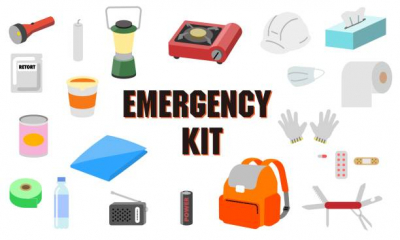Emergency Supply Kit Checklist
During an emergency, it can take three (3) days or longer for government groups like FEMA or first responders to arrive. Remember, hope for 3 days, plan for 5!
Assemble your Emergency Supply Kit now. Put everything in a special box and keep heat-sensitive items inside your house; rotate the stock throughout the season:
6 Basics to stock from home:
- Water
- Food
- First Aid Supplies
- Clothing and Bedding
- Tools and Emergency Supplies
- Special Items
Click HERE for a printable flyer of the Emergency Supply Kit Checklist
FOOD:
Store at least a 3-day supply of non-perishable food (requires no refrigeration, preparation / cooking, and little or no water). If you must heat food, pack a can of Sterno.
- Ready-to-eat canned meats, fruits, & vegetables.
- Canned juices
- Staples (salt, sugar, pepper, spices, etc.)
- High-energy foods
- Vitamins
- Food for infants
- Comfort/stress foods
WATER:
Store water in plastic containers such as soft drink bottles. Avoid using containers that will decompose or break, such as milk cartons or glass bottles. A normally active person needs to drink at least two quarts of water each day. Hot environments and intense physical activity can double the amount. Children, nursing mothers, and people with illnesses will nee more water.
- Store one gallon of water per person per day (for at least 3 days).
FIRST AID KIT:
Assemble a first aid kit for your home and one for each car.
- (20) adhesive bandages, various sizes
- (1) 5” x 9” sterile dressing
- (1) conforming roller gauze band-age
- (2) triangular bandages
- (2) 3 x 3 sterile gauze pads
- (2) 4 x 4 sterile gauze pads
- (1) roll 3” cohesive bandage
- (2) germicidal hand wipes or waterless alcohol-based hand sanitizer
- (6) antiseptic wipes
- (2) pair large medical grade non-latex gloves
- Adhesive tape, 2” width
- Anti-bacterial ointment
- Cold pack
- Scissors (small, personal)
- Tweezers
- CPR breathing barrier, such as a face shield
NON-PRESCRIPTION DRUGS:
- Aspirin or non-aspirin pain reliever
- Anti-diarrhea medication
- Antacid (for stomach upset)
- Laxative
- Activated charcoal (use if advised by the American Association of Poison Control Centers)
TOOLS AND SUPPLIES:
- Mess kits, or paper cups, plates, and plastic utensils
- Emergency preparedness manual
- Battery-operated radio and extra batteries
- Flashlight and extra batteries
- Cash and/or change
- Non-electric can opener, utility knife
- Fire extinguisher: small canister ABC type
- Tube tent
- Pliers
- Tape
- Compass
- Lighter or matches in a waterproof container
- Aluminum foil
- Plastic storage containers
- Signal flare
- Shut-off wrench to turn off household gas and water
- Whistle
- Plastic sheeting
- List of local shelters
SANITATION:
- Toilet paper, towelettes
- Soap, liquid detergent
- Feminine supplies
- Personal hygiene items
- Plastic garbage bags, ties (for personal sanitation uses)
- Plastic bucket with tight lid
- Disinfectant
- Household chlorine bleach
CLOTHING AND BEDDING:
Include at least one complete change of clothing and footwear per person.
- Sturdy shoes or work boots
- Rain gear
- Blankets or sleeping bags
- Hat and gloves
- Thermal underwear*
- Sunglasses
Special Items
FOR BABY:
- Formula
- Diapers
- Bottles
- Powdered milk
- Medications
FOR ADULTS:
- Heart and high blood pressure medication
- Insulin
- Prescription drugs
- Denture needs
- Contact lenses and supplies
ENTERTAINMENT:
- Board games and other games that don’t require batteries or electricity, books for adult readers and for children.
Possessions and Documents
**Keep these records in a water-proof, portable container:
- Will, insurance policies, con-tracts deeds, stocks and bonds
- Passports, social security cards, immunization records
- Bank account numbers
- Credit card account numbers and companies
- Inventory of valuable household goods, important telephone numbers
- Family records (birth, marriage, death certificates)
- Store your kit in a convenient place known to all family members. Keep a smaller version of the supplies kit in the trunk of your car. Keep items in airtight plastic bags.
- Change your stored water sup-ply every six months so it stays fresh.
- Replace your stored food every six months.
- Re-think your kit and family needs at least once a year. Replace batteries, update clothes, etc.
- Ask your physician or pharmacist about storing prescription medications.
FOR PETS:
- Securely fasten a current identification tag to your pet’s collar and carry a photography of your pet. It’s important to include the phone number of a friend or family member on the tag so anyone who may find your pet is able to reach someone who knows you.
- Transport pets in secure pet carriers and keep pets on leashes or harnesses.
- Call hotels in a safe/host location and ask if you can bring your pets. Ask the manager if a no-pet policy can be lifted during the disaster. Most emergency shelters do not admit pets.
- Call friends, family members, veterinarians, or boarding kennels in a safe/host location to arrange foster care if you and your pets cannot stay together.
- Pack a week’s supply of food, water, and other provisions, such as medication or cat litter.
- Do not wait until the last minute to evacuate. Rescue officials may not allow you to take your pets if you need to be rescued.
- Keep a list of emergency phone numbers (veterinarian, local animal control, animal shelters, Red Cross, etc.)

